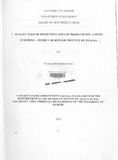| dc.description.abstract | The different ways in which peasant use their available resources to produce both social and material products have for long thought to associated with low productivity. The farm inputs used and the activities as well as practices involved in peasantry production process were either said to contribute to low agricultural production or to affect the individual's ability to produce.
The main objectives of this study were to look into how the farm inputs used in peasant mode of production, including land use and cropping patterns in Buhoma district contribute to low agricultural production. The study also aimed at assessing how personal characteristics of the small scale farmer influence their level of productivity, on one hand, and how individual' s involvement in peasantry affect his/her personal profile on the other.
The rational of the study was to expose peasants in Buhoma district and else where in the developing countries to different ways in which the production among peasants is brought about, and the major obstacles that slow its realization. To this extent, many peasants would learn to exploit the alternative used that might be more beneficial and affordable for their betterment; hence contributing to the rural development as a whole.
Many scholars including Atiurrahman (1986) observed that low productivity among peasants could as a result of relying much on the family labor.
The theory of the peasantry also maintain that peasant mode of production' s low ability can be explained by its strong reliance on the unpaid family labor. In addition, the modernization theorist maintain that peasantry low productivity is due to the fact peasant peasants rely on the traditional way of production, and suggests the introduction of modern technology as a way of improving productivity. However, the ecological theorists consider both the internal and external environment to also have power to influence peasantry production process.
The field observations in Buhoma district found that peasant mode of production could also lead to low productivity in some aspects. On the part of the individual peasant suffering the peasant mode of production, it was observed that people who had involved too much in some of the peasant activities missed the opportunity to further their education, hence lowering their ability to produce to the desired results. On the part ofthe peasantry production process, the study revealed that some different forms of land use and cropping patterns could lead to low productivity in some crops. For instance, fixed tenant arrangement, share cropping, and others were appreciated for providing access to land for production for those with little or no land at all, but criticized for not allowing both tenant farmer and peasant landlord not to have access to production of certain types of essential cash crops because of having a temporary right to land. In terms of crop growth, the study revealed that some modem farm inputs such as chemical fertilizer could lead to slow crop growth, in some cases instead of speeding it up as it was commonly believed. | en_US |

